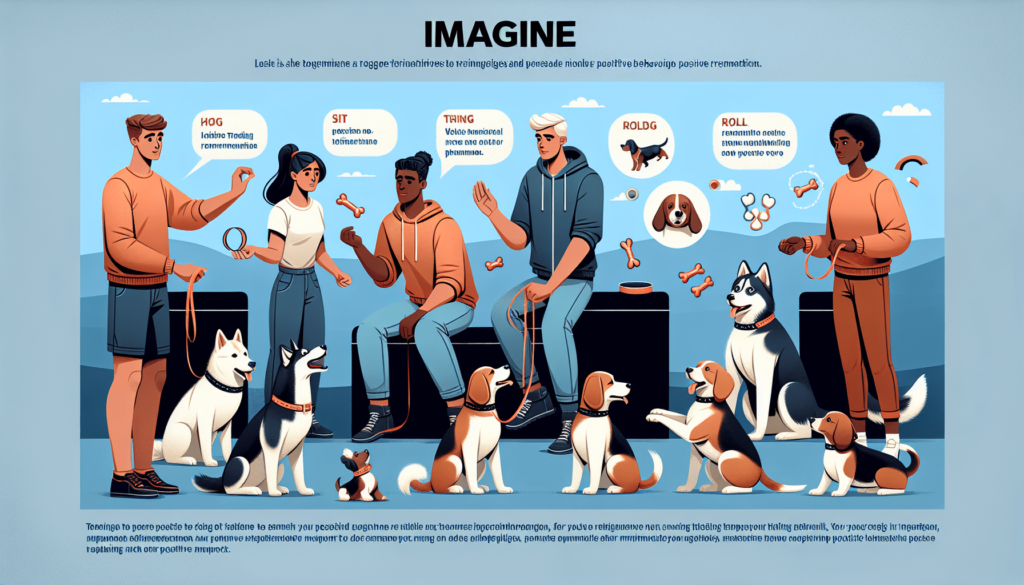Have you ever wanted to impress your friends and family with the skills of your furry companion? Well, look no further! In this article, you will discover the art of teaching tricks to your dog. From simple commands like sit and stay to more advanced tricks like roll over and play dead, we will explore the techniques and tips that will have your dog performing like a real superstar. So grab some treats and get ready to unlock your dog’s hidden potential in this entertaining and informative guide.
Choosing the Right Tricks
When it comes to teaching tricks to your dog, it’s important to choose ones that are appropriate for your furry friend. This means considering their abilities, personality, and breed. By analyzing these factors, you can select tricks that will not only be enjoyable for your dog but also achievable for them to learn.
Analyzing Your Dog’s Abilities
Take a moment to observe and evaluate your dog’s abilities. Are they naturally agile and quick learners, or do they need a bit more time and patience? By understanding their strengths and weaknesses, you can choose tricks that align with their abilities. For example, if your dog loves to chase and retrieve, teaching them to fetch or play frisbee might be perfect for them.
Considering Your Dog’s Personality
Just like humans, dogs have distinct personalities. Some dogs are outgoing and highly motivated to please, while others may be more reserved or independent. Consider your dog’s personality when selecting tricks. For an outgoing dog, tricks that involve interacting with people, such as high fives or playing dead, may be a good fit. However, for a more independent dog, tricks that involve problem-solving, such as searching for hidden treats, may be more engaging for them.
Selecting Tricks Based on Your Dog’s Breed
Different dog breeds have different physical and mental characteristics, which can affect their aptitude for certain tricks. For example, a Border Collie, known for their intelligence and agility, may excel at complex tricks like weaving through poles or jumping through hoops. On the other hand, a Bulldog, with their muscular build, may be better suited for tricks that involve strength, such as pulling a mini cart or balancing on a stability ball. Choose tricks that align with your dog’s breed traits to set them up for success.
Creating a Positive Learning Environment
Creating a positive learning environment is crucial when teaching tricks to your dog. This involves using positive reinforcement, avoiding punishment, and being patient and consistent throughout the training process.
Using Positive Reinforcement
Positive reinforcement is a powerful tool in training dogs. It involves rewarding your dog with treats, praise, or play whenever they perform the desired behavior. By associating the trick with positive outcomes, such as tasty treats or a fun game of fetch, your dog will be motivated to repeat the behavior. Remember to reward your dog immediately after they perform the trick correctly to reinforce the connection between the behavior and the reward.
Avoiding Punishment
Punishment can hinder the learning process and damage the trust between you and your dog. Instead of using punishment or scolding when your dog makes a mistake, focus on redirecting their attention and rewarding them for positive behavior. Dogs respond best to positive reinforcement, so stick to this approach to maintain a safe and nurturing learning environment.
Being Patient and Consistent
Teaching tricks to your dog takes time, patience, and consistency. Remember that each dog learns at their own pace, so be patient throughout the training process. Break down the tricks into small, manageable steps, and gradually increase difficulty as your dog progresses. Consistency is key in reinforcing the learned behaviors, so practice regularly and ensure everyone in the household is using the same commands and techniques.

Teaching Basic Commands
Before diving into more advanced tricks, it’s important to establish a foundation of basic commands. These commands will provide a solid framework for future trick training and help improve your dog’s overall obedience.
Start with Sit and Stay
The commands “sit” and “stay” are essential for any well-behaved dog. Begin by teaching your dog to sit on command. Hold a treat close to their nose, then slowly move it up and back over their head. As their head follows the treat, their bottom should naturally lower into a sitting position. Once they are sitting, say “sit” and immediately reward them with the treat and praise. Repeat this process until your dog consistently responds to the “sit” command.
Once your dog has mastered sitting, you can move on to teaching them to stay. Start with your dog in a sitting position, then extend your hand, palm facing your dog, and say “stay” in a calm and firm tone. Take a step back, then step forward and reward your dog with praise and a treat if they remain in the sitting position. Gradually increase the distance and duration of the stay as your dog becomes more comfortable with the command.
Teach Your Dog to Come
The command “come” is an essential skill for your dog’s safety and your peace of mind. Begin by getting down to your dog’s level and saying their name followed by “come” in an enthusiastic tone. When they come to you, reward them with praise and a treat. Practice this command in a controlled environment before gradually introducing distractions. Remember to always reward and praise your dog when they respond correctly, reinforcing the positive association with coming when called.
Introduce the Command ‘Leave It’
The command “leave it” is particularly useful for preventing your dog from picking up or consuming harmful objects. Hold a treat in your closed fist and present it to your dog. When they try to sniff or paw at your hand, say “leave it” and keep your hand closed. Wait for a moment of disengagement, then open your hand and reward them with a different treat. Repeat this process, gradually increasing the difficulty by placing the treat on the ground or using more tempting objects. With practice, your dog will learn to understand and obey the “leave it” command.
Building on Basic Commands
Once your dog has mastered the basic commands, you can start building on those skills by teaching them more advanced tricks. This will not only challenge them mentally and physically but also deepen the bond between you and your furry friend.
Progressing to More Advanced Tricks
Once your dog is confident with basic commands, you can gradually introduce more advanced tricks. Some popular options include rolling over, playing dead, or jumping through hoops. Break down these tricks into smaller steps, and use positive reinforcement to guide your dog through each stage of learning. Remember to be patient and celebrate every small success, as it will motivate your dog to continue learning and trying new things.
Teaching Your Dog to Lie Down
The “lie down” command is a natural progression from the “sit” command. Start with your dog in a sit position, then hold a treat close to their nose and slowly move it towards the ground. As their head follows the treat, their body should naturally lower into a lying position. Once they are lying down, say “lie down” and reward them with the treat and praise. Gradually phase out the treat and reinforce the behavior with praise alone.
Teaching Your Dog to Shake Hands
Teaching your dog to shake hands is a fun trick that also encourages good manners. Start by commanding your dog to sit. Once they are sitting, extend your hand towards them and say “shake.” Gently lift their paw, shake it lightly, and immediately reward them with praise and a treat. Repeat this process, gradually increasing the duration of the handshake. With practice, your dog will learn to associate the verbal cue with the action of shaking hands.

Adding Distance and Duration
As your dog becomes more adept at performing tricks, it’s important to gradually increase the distance and duration of their actions. This will help them generalize their skills and perform tricks in different environments and situations.
Gradually Increase Distance
Begin by practicing the tricks your dog has learned in a familiar, controlled environment. Once they are consistent in performing the tricks, start gradually increasing the distance between you and your dog. For example, when teaching your dog to retrieve an object, initially stand close to them and toss the object a short distance. Gradually increase the distance as your dog becomes more confident and skilled.
Slowly Extend Duration of Tricks
After your dog has mastered a trick, work on extending the duration of their performance. For example, if teaching your dog to stay, start with short durations and gradually increase the time before releasing them. This will build their patience and focus while reinforcing their understanding of the command.
Proofing Tricks in Different Environments
Once your dog has mastered a trick in one environment, it’s important to practice in different locations and with various distractions. This will help your dog generalize their learning and perform tricks consistently, regardless of the environment. Start with low-distraction environments, such as your backyard, and gradually introduce new locations with increasing distractions. By systematically exposing your dog to different environments, they will become more adaptable and reliable in their trick performances.
Using Hand Signals and Verbal Cues
In addition to verbal cues, hand signals can be an effective way to communicate with your dog during trick training. Introducing hand signals alongside verbal cues can enhance your dog’s understanding and responsiveness.
Teaching Hand Signals
To teach hand signals, start by associating a specific hand gesture with each trick or command. For example, for the “sit” command, raise your hand palm-up in front of your dog. Pair this hand gesture with the verbal cue “sit” as you guide your dog into the sitting position. Over time, your dog will begin to associate the hand signal with the desired behavior. Practice the hand signals consistently alongside the verbal cues to reinforce the connection between the two.
Pairing Verbal Cues with Actions
When teaching tricks, it’s important to use verbal cues consistently alongside the desired actions. For example, when teaching your dog to lie down, say “lie down” as you guide them into the position. The verbal cue should be timed to coincide with the action, helping your dog understand the correlation between the command and the behavior. Pairing verbal cues with actions will improve your dog’s responsiveness and strengthen the communication between you.
Transitioning to Verbal Cues Only
Once your dog is proficient in performing tricks with both hand signals and verbal cues, you can begin to transition to verbal cues only. Gradually reduce the use of hand signals while relying more on your voice. Ensure that your dog consistently responds to the verbal cues, even without the visual prompts. Consistency and gradual transition are key to avoid confusing your dog during this stage. Celebrate their success as they become more reliant on your verbal commands, building a stronger bond and understanding between you.
Troubleshooting Challenges
During the process of teaching tricks, you may encounter various challenges. Addressing these challenges promptly and effectively will ensure a smooth learning experience for both you and your dog.
Dealing with Distractions
Distractions can pose a challenge when training your dog, especially when working on more advanced tricks. If your dog becomes distracted, take a step back and practice in a quieter environment before gradually reintroducing distractions. Use high-value treats or toys to regain their focus and reward them for ignoring distractions. Practice patience and consistency, slowly increasing the difficulty level as your dog becomes more adept at maintaining their focus.
Addressing Fear or Shyness
Some dogs may display fear or shyness during trick training, especially when exposed to new experiences or equipment. It’s essential to approach these situations with empathy and patience. Gradually introduce new environments or objects, starting with low-intensity exposures. Use positive reinforcement, such as treats and praise, to build their confidence and associate positive experiences with the previously feared stimuli. If necessary, seek professional help from a dog trainer or behaviorist who specializes in working with fearful dogs.
Modifying Techniques for Older Dogs
As dogs age, they may experience physical limitations that can impact their ability to perform certain tricks. It’s important to consider your dog’s age and fitness level when selecting and teaching tricks. Make any necessary modifications to accommodate their physical abilities, ensuring that they can comfortably and safely perform the tricks. Focus on low-impact exercises and mentally stimulating activities that cater to their specific needs. Always consult with your veterinarian to ensure your older dog’s health and well-being are prioritized during trick training.
Ensuring Safety during Tricks
When teaching tricks to your dog, their safety should always be your top priority. By practicing in safe areas, avoiding tricks that cause discomfort, and monitoring physical limitations, you can ensure a safe and enjoyable training experience for both you and your furry companion.
Practicing Tricks in Safe Areas
Choose safe and secure areas for practicing tricks with your dog. This could be your backyard, a quiet park, or even an indoor training space. Ensure there are no hazards or distractions that could pose a risk to your dog’s well-being. By providing a controlled environment, you can focus on the training without worry.
Avoiding Tricks that Cause Discomfort
Every dog is unique, and some tricks may cause discomfort or stress for certain individuals. Avoid tricks that could potentially harm or distress your dog physically or mentally. For example, certain jumps or acrobatic tricks may be unsuitable for dogs with joint issues. Always prioritize your dog’s well-being and choose tricks that are safe and enjoyable for them.
Monitoring Physical Limitations
When teaching tricks to your dog, it’s crucial to be aware of their physical limitations. Larger or older dogs may have limitations in terms of flexibility or endurance. Adjust the difficulty level and physical demands of the tricks to accommodate your dog’s individual capabilities. Regularly monitor your dog for any signs of fatigue or discomfort, and consult with your veterinarian if you have any concerns about their physical well-being.
Taking Tricks to the Next Level
Once your dog has mastered a range of tricks, you can explore opportunities to take their skills to the next level. This could involve participating in dog agility or freestyle events, expanding their repertoire with new tricks, or even competing in trick dog titles.
Participating in Dog Agility or Freestyle
Dog agility and freestyle are exciting sports that showcase the skills and teamwork between dogs and their handlers. Agility involves navigating through an obstacle course, while freestyle allows for creative expression through choreographed routines. Participating in these activities can provide mental and physical stimulation for your dog while strengthening the bond between you. Enroll in classes or join local dog sports clubs to refine your skills and participate in competitions if desired.
Expanding Repertoire with New Tricks
Keep expanding your dog’s repertoire by continually challenging them with new and interesting tricks. This will keep their minds sharp and prevent boredom. Look for inspiration in books, online tutorials, or by observing other well-trained dogs. Break down complex tricks into smaller steps and use positive reinforcement to guide your dog through the learning process. The possibilities are endless, so have fun exploring new tricks together.
Competing in Trick Dog Titles
If you and your dog enjoy the thrill of competition, consider entering trick dog titles. Organizations such as the American Kennel Club (AKC) offer trick dog programs that allow you to earn titles based on your dog’s repertoire of tricks. These programs provide structured guidelines and evaluation criteria to showcase your dog’s abilities. Participating in trick dog titles not only showcases your dog’s skills but also provides a sense of accomplishment and recognition for your hard work.
Building a Strong Relationship with Your Dog
Beyond teaching tricks, the process itself is an opportunity to strengthen the bond and relationship with your dog. Enjoy the journey of teaching tricks, focus on bonding and trust building, and always recognize and reward your dog’s efforts.
Enjoying the Process of Teaching Tricks
Remember to have fun throughout the trick training process. Celebrate the small victories, and don’t get discouraged by setbacks or challenges. Training sessions should be enjoyable for both you and your dog, so maintain a positive and enthusiastic attitude. Dogs are perceptive creatures, and they pick up on your emotions. By approaching training with excitement and joy, you will create a positive and engaging experience for your furry friend.
Bonding and Trust Building
Teaching tricks can be a wonderful opportunity to strengthen the bond and trust between you and your dog. By spending dedicated time together, communicating effectively, and offering praise and rewards, you will build a deeper connection with your furry companion. Use trick training as a way to enhance your relationship and create positive memories together.
Recognizing and Rewarding Your Dog’s Efforts
Each step of learning a new trick is an achievement in itself. Recognize and reward your dog’s efforts, even if they haven’t mastered the entire trick yet. Offer verbal praise, gentle petting, and their favorite treats as a token of appreciation. This positive reinforcement will motivate your dog to continue learning and performing tricks, strengthening their confidence and trust in you.
In conclusion, teaching tricks to your dog is not only a fun and engaging activity but also a wonderful opportunity to strengthen the bond between you. By choosing the right tricks, creating a positive learning environment, and gradually building on basic commands, you can empower your dog to showcase their skills and intelligence. Remember to prioritize their safety, address any challenges that may arise, and enjoy the process of teaching and learning together. So embrace the art of teaching tricks to your dog and embark on an exciting journey filled with joy, growth, and companionship.

